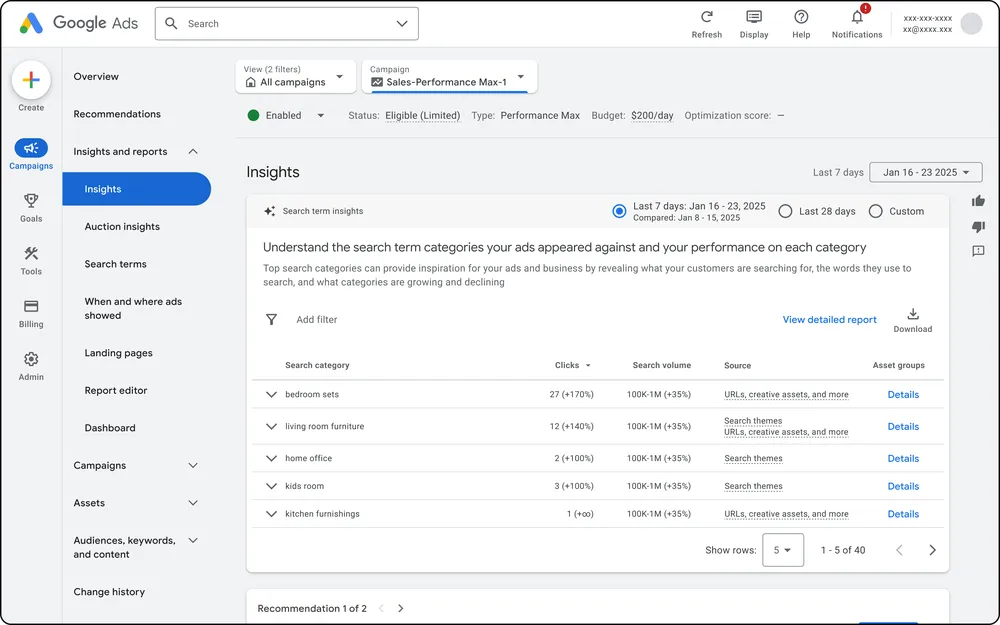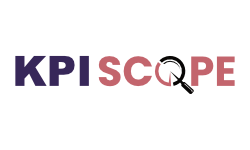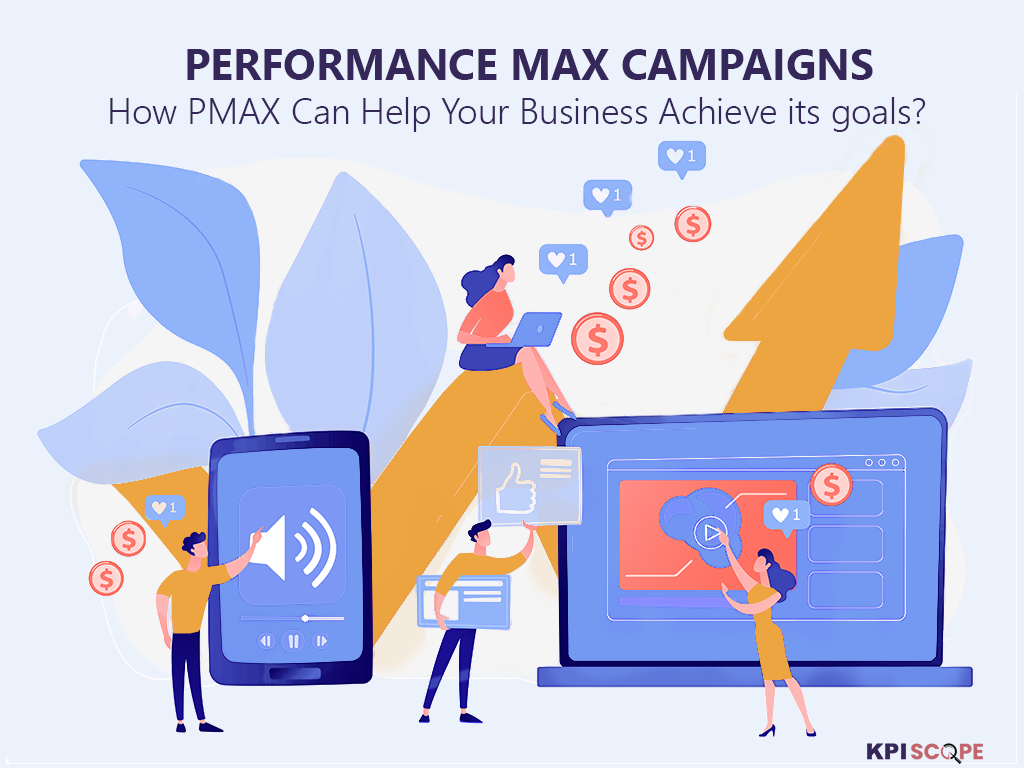What are Performance Max campaigns?
Performance Max campaigns (PMAX) are a powerful tool that can help businesses achieve their key performance indicators (KPIs). By leveraging Google’s advanced machine learning algorithms, they can drive conversions across a wide range of channels, including Search, Display, YouTube, Discover, Gmail, and Maps. This means that businesses can reach their target audience wherever they are online, increasing brand awareness, leads, and sales.
Understanding Performance Max
- Performance Max is a goal-based campaign type, meaning that businesses can set specific conversion goals and let Google’s AI optimize campaigns to achieve those goals.
- Smart Bidding: This AI-powered system automatically adjusts bids in real-time to maximize conversions or conversion value.
- PMax also automates creative testing, so businesses can experiment with different combinations of assets to find the most effective ones.
How do Performance Max campaigns work?
Performance Max operates on the principle of automation, using machine learning models to optimize bids, placements, and creative combinations in real-time. The system uses Smart Bidding to achieve your specified conversion goals. To effectively drive conversions, Google’s AI considers various factors including:
- Audiences
- Creatives
- Budget optimization
- Bidding strategy
- Attribution
- Essentially, you provide the necessary inputs, and Google’s AI does the heavy lifting to optimize your campaigns.
How can Performance Max campaigns help your business?
Here are some specific examples:
- Increase Website Traffic and Leads: Performance Max campaigns can drive more traffic to your website by reaching a wider audience across Google’s network. This increased visibility can lead to more leads and ultimately, more customers.
- Boost Sales and Revenue: By optimizing for conversions or conversion value, PMax campaigns can help businesses increase sales and revenue. The ability to target users across multiple platforms allows businesses to connect with potential customers at various stages of the buying journey.
- Improve Brand Awareness: By appearing on a variety of channels, Performance Max campaigns can help businesses reach new audiences and increase brand awareness. This can be especially beneficial for businesses launching new products or services or expanding into new markets.
- Gain Valuable Customer Insights: While PMax restricts access to some granular data, it still provides insights into top-performing audience segments and search categories. Businesses can use this information to refine their targeting strategies and better understand their customer base.
Maximizing Performance Max Effectiveness
- Accurate Conversion Tracking: Set up accurate conversion tracking to give Google’s AI the data it needs to optimize for your desired outcomes. Without accurate tracking, PMax may struggle to deliver the desired results.
- High-Quality Creative Assets: Provide a variety of high-quality creative assets, including images, videos, headlines, and descriptions, to ensure your ads are engaging and effective. This will give Google’s AI more options to work with and improve the chances of finding winning combinations.
- Targeted Audience Signals: Include relevant audience signals, like customer lists, website visitors, and in-market segments, to help Google quickly identify and target potential customers.
- Strategic Bidding and Budget: Define a clear bidding strategy, setting appropriate targets for CPA or ROAS. Ensure your budget is sufficient to allow the campaign to learn and optimize effectively.
Advantages and Disadvantages of Performance Max Campaigns
Performance Max offers distinct advantages but also comes with certain drawbacks.
PMax Advantages:
- Cross-platform reach: Reaches users across Google’s entire advertising inventory, potentially expanding audience reach.
- Automated bidding: Leverages Google’s AI to optimize bids, saving time and effort.
- Simplified campaign management: Provides unified reporting, reduces manual tasks, and offers a relatively easy setup.
- Advanced creative capabilities: Allows diverse ad formats, with Google automatically testing for optimal combinations.
- Adaptiveness: Machine learning algorithms adjust quickly to user behavior changes, market trends, and seasonality.
PMax Disadvantages:
- Potential for cannibalization: May compete with other campaigns for the same keywords and audiences, potentially diminishing overall results.
- Heavily reliant on conversion data for optimization, which can hinder performance for businesses with limited conversion history.
- Lack of control and transparency: Limited control over ad creatives, targeting, and bidding. Performance data is restricted, making it difficult to understand performance and optimize effectively.
Cannibalization in Performance Max Campaigns
Yes, there can be brand or category cannibalization when using PMax campaigns.
- Brand Cannibalization: This occurs when your Performance Max campaigns start competing with your existing brand campaigns, potentially driving up costs and reducing overall efficiency. Since PMax is automated and can target a wide range of keywords, it may end up bidding on branded terms that you’re already targeting in dedicated brand campaigns. This competition can lead to your campaigns effectively bidding against themselves, pushing up costs and potentially lowering your overall return on investment.
- Category Cannibalization: Similar to brand cannibalization, category cannibalization can happen if your Performance Max campaigns begin competing with other campaigns focused on specific product categories.
Addressing Cannibalization
What can we do to minimize cannibalization in PMax campaigns?
- Negative Keywords: You can use negative keyword lists to prevent them from bidding on specific terms, such as your brand terms. This helps ensure that your brand campaigns remain focused on capturing branded searches without interference from PMax. Previously, adding negative keywords to the PMax required a request to a Google representative. However, with the recent launch of a beta version, negative keywords can now be added directly at campaign level (read more here).
- Monitoring and Optimization: It’s crucial to regularly monitor the performance of your Performance Max campaigns and compare them to your other campaigns. By analyzing search categories and audience segments in the Insights tab, you can identify potential areas of overlap and adjust your bidding strategies or negative keyword lists accordingly.

Key Takeaway: While Performance Max can be a powerful tool for driving conversions, it’s essential to be aware of the potential for cannibalization. By strategically using negative keywords and closely monitoring campaign performance, you can mitigate this risk and ensure your campaigns work together effectively.
The Challenge of Measuring Performance Max ROI
Performance Max’s strength – its automation – also presents a challenge when it comes to measuring its precise impact on revenue.
- The ‘Black Box’ Effect: PMax was often referred to as a “black box” because it lacks granular performance data. While you could see overall results, it was difficult to pinpoint exactly how each element of the campaign contributes to revenue. However, as of October 2024, Google has enhanced visibility on asset performance (read more here: Performance Max: Deeper insights, better results).
- Factors Beyond Performance Max: Numerous factors outside of the campaign itself can impact revenue, making it tough to isolate Performance Max’s contribution. These include your industry, budget, conversion tracking accuracy, and the quality of your creative assets.
What average incremental revenues do Performance Max campaings bring?
How much revenue can you actually expect to gain? Here’s what the data tells us:
- More Conversions, More Revenue? According to Google, most retailers are already using PMax and seeing great results. And beyond retail, advertisers who adopt Performance Max see an average increase of 27% more conversions or value at a similar CPA/ROAS. This is even when they already use broad match and Smart Bidding in their Search campaigns (read more: PMax convertion)
- Real-World Revenue Wins: Case studies show how PMax can translate to substantial revenue gains:
How to measure the incremental impact of a Performance Max Campaign?
Google Ads has introduced Performance Max Experiments, empowering advertisers to enhance their campaigns through A/B testing. These experiments, accessible via the Experiments page, offer two primary types:
PMax Uplift Experiments: These assess the incremental benefits of integrating Performance Max campaigns alongside existing Search, Video, and Display campaigns.
PMax vs. Standard Shopping Campaign Experiments: These enable a direct comparison between Performance Max and Standard Shopping campaigns to determine which yields superior results.
What’s new in Performance Max Campaigns in 2025?
More campaign controls to steer AI
- Campaign-level negative keywords (beta was released in 2024 and now is available to all advertisers)
- New customer acquisition goal with high value mode
- Brand exclusions for different formats in retailer campaigns with product feeds
- “URL contains” rules for campaigns with product feeds
- Demographic exclusions
- Device targeting
Deeper Search reporting
- Search themes usefulness indicator
- Search terms insights source column
Improved asset group reporting
- Ability to segment and download asset group performance
Conclusions
Performance Max is a powerful advertising solution that can help businesses of all sizes achieve their goals. It can streamline campaign management, optimize bidding and targeting, and deliver results across Google’s expansive network.
However, as advertisers, we need to understand the nuances of PMax, including its reliance on conversion data and its limited (not so limited now) transparency, to make informed decisions and maximize campaign effectiveness.
By following best practices and working closely with Google representatives or certified partners, businesses can harness the power of Performance Max to achieve their marketing goals and drive business growth.


